Mahonia holly in landscape design, varieties, planting and propagation

Mahonia holly is used in landscape design to create hedges, decorate hillsides and add beauty to flower beds. It has the additional name "Oregon grape".
Content:
- Mahonia holly: characteristics, description of the plant and variety
- What does Japanese mahonia look like in the photo?
- Health benefits and harms of plants
- Transplantation of mahonia holly, plant care
- Reproduction of Mahonia holly
- Mahonia crown pruning and formation
- Organization of wintering
- Using mahonia for domestic purposes
- How is Mahonia holly used in landscape design?
- Combination with other plants
- Conclusion
Mahonia holly: characteristics, description of the plant and variety
The homeland of Mahonia holly is North America. It was from here that in the 20s of the 19th century the plant migrated first to Europe, and then to Russia. But in our country this shrub is still not very widespread.
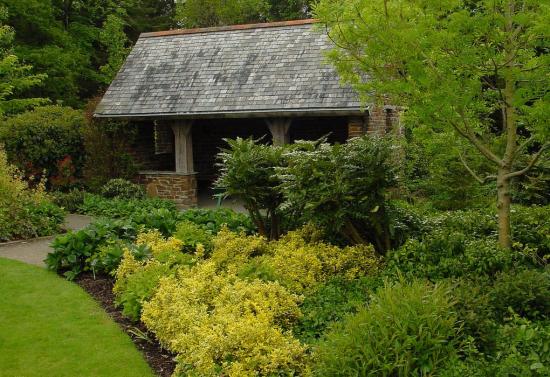
This is surprising because it does not require special care and can easily withstand winters. And its dark blue berries can even be eaten.
The plant is widely used in landscape design due to its uniqueness and attractiveness. It is a rather tall shrub, up to 150 cm. It has pinkish-gray bark (the shade becomes dark gray as the plant matures!).
It blooms from late May to mid-June with small yellow flowers collected in paniculate inflorescences. The fruits appear in August, but ripen only in mid-September. In appearance, they resemble grapes (hence the second name!). The taste is sweet and sour.
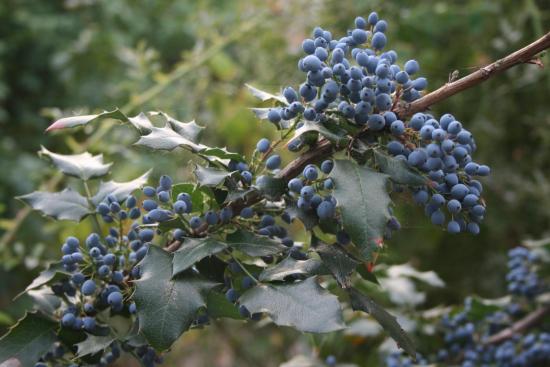
Mahonia is able to withstand frost and is considered evergreen. Looks good on any site. Depending on the season, the color of the leaves changes: in the warm season they are green, in the fall they become brown, purple, dark red or even black.
To decorate the area and obtain berries, you can use the following plant varieties:
| Gracilis | Shrub with long green leaves |
| Atropurpurea | With leaves that change color from purple to almost black in winter |
| Smaragd | With yellow inflorescences and black berries |
| Apollo and Jupiter | Varieties are characterized by large inflorescences and a compact crown |
| Jugandifloria | The leaves of which resemble walnut leaves in appearance. |
It is worth noting that mahonia holly is a “close relative” of barberry; it is part of the same family with it. It is also cross-pollinated. That is, to collect berries, you need to plant 2-3 shrubs side by side. Otherwise there will be no fruit, this is a fact.
You can buy mahonia seedlings in specialized stores or in tree nurseries. They are hard to find on the regular market.
What does Japanese mahonia look like in the photo?
In addition to being holly-leaved, mahonia comes in the following types:
- Creeping, no more than 50 cm high, blue-green, sharp-toothed foliage, with a matte coating. The fruits are dark blue, with fluff. Blooms at the end of May, harvest in September.
- Japanese tall tree, with gray bark. The leaves are up to 50 cm in size. The flowers are small, yellowish.Blooms at the end of May, ripens by autumn.
- Fremonti is a shrub up to three meters, the leaves are gray-green, changing color as the plant ages. The berries are dark red.
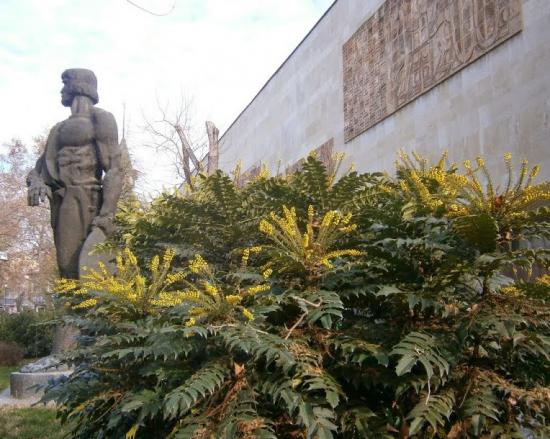
Regardless of the type, mahonia in the photo looks like an ornamental plant that not only blooms beautifully, but also bears fruit.
Health benefits and harms of plants
What is important is that mahonia holly is very beneficial for the human body. Almost all of its parts can be used for medicinal purposes.
Thus, the bark is often used to treat psoriasis and other skin diseases; Experts create a special extract from the roots that can help treat the lungs and heart.
Homeopaths create antibacterial agents from the leaves. And berries help well with high blood pressure, they normalize it.
The roots of Mahonia holly also have healing properties. Medicines are made from them, which are useful for gastritis, blockage of the biliary tract, giardiasis and hepatitis.
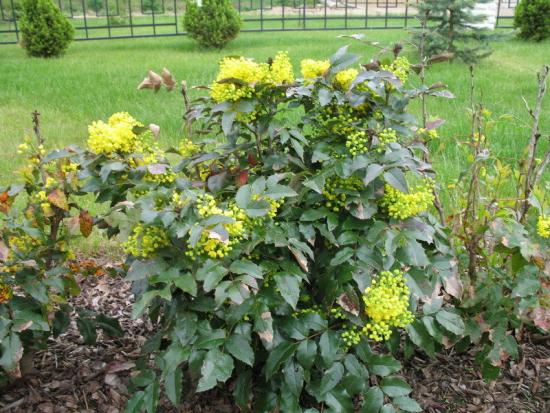
Externally, such drugs can be used to get rid of herpes, swelling and acne. It is only important not to forget to consult a doctor before using the product. Self-medication does not bring any good!
Transplantation of mahonia holly, plant care
This plant is easy to grow. Mahonia is undemanding to soil, but grows best in slightly acidic soil, with the addition of sand and humus. Does not like stagnant water and direct sunlight. It is better to prepare a place in the shady part of the site and not blown by the winds. Mahonia grows slowly.
When it gets big, it grows a lot. Therefore, if several bushes are planted, the distance between them should be more than one meter.
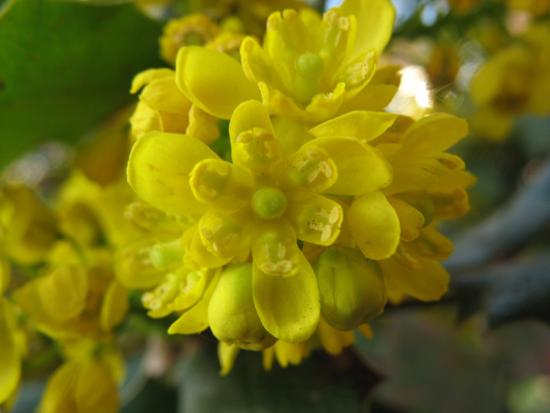
The planting procedure must be carried out in the following sequence:
The soil needs to be dug up 2 weeks after planting the seedling.
- After another 7 days, make holes measuring 50*50 cm in the loosened area.
- Immediately fill them with a nutritious mixture of fertile soil, peat and manure.
- Pour fine crushed stone or split brick onto the bottom in a layer of up to 10 cm (for drainage). Sprinkle everything on top with earth.
- Wait until the soil settles and becomes more dense.
- Prepare the seedlings: remove all very long, diseased and dry roots.
- Immediately treat the cuts with charcoal, crushed into powder.
- Place the bushes in the holes and cover their roots with fertile soil, making sure that the root collar remains above the ground.
- Lightly compact the soil around the seedlings and sprinkle with mulch.
The transplantation process can be carried out in spring or summer. This should not be done in the fall, since the plant needs a lot of time to take root firmly and gain strength.
Caring for mahonia consists mainly of weeding, watering and feeding the bushes with fertilizers. The plant rarely gets sick. But if it suddenly “caught” some kind of fungal disease, it is treated quickly. To do this, it is often enough to spray with a solution of special preparations.
You will learn even more about the rules for growing mahonia holly by watching the video:
[https://youtu.be/fKrg5ssQoNg]
Reproduction of Mahonia holly
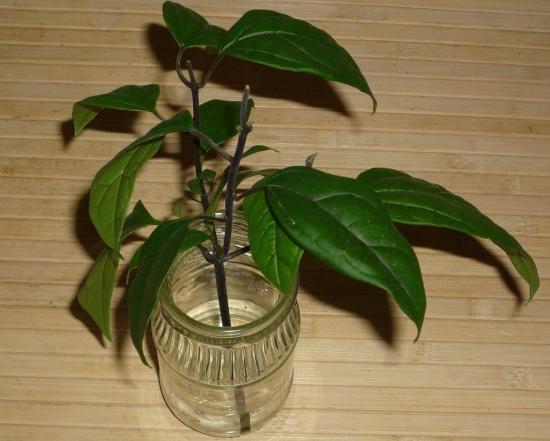
This plant is propagated like most others:
- Seeds are sown in September, sprouts hatch in May. Further growth occurs in a greenhouse; they are planted in open ground after reaching four years of age.The planting procedure is carried out as follows: take the washed seeds, place them on a damp cloth, put them in a plastic container, and close them. After the sprouts appear, they are placed in a pot filled with fertile soil and watered.
- Using cuttings, several shoots with leaves are cut at an angle, and “Kornevin” is applied to the lower edge of the cut. After which the shoot is immersed in the ground. To accelerate its growth, special baits are used: decomposed organic materials or purchased mixtures. After placing in the soil, the cutting is covered with a transparent plastic bottle to protect it from external negative factors. This method is good for obtaining many seedlings.
- Layers inspect the roots of the plant before planting; diseased and dried ones are immediately removed. The lower branches are dug in, when roots and shoots appear, they are cut off and replanted. Throughout the summer, the bushes are periodically watered with water to prevent the soil from drying out.
- Another interesting method is planting using branches. To do this, in late autumn, cut off several branches and place them in a container with water. After the roots appear, the shoot is moved to a pot. Then just water regularly and provide good lighting. A year later, the seedling is planted in open ground.
Mahonia crown pruning and formation
The crown of a plant is cut off in three cases: if the bush has become too tall and no longer fits into the overall picture; in the presence of a bare area and for the purpose of rejuvenation. They do this in April. Usually only those buds that do not have flower buds are cut off.
Everything is cut off completely only if the bush is severely deformed. Mahonia recovers quickly, so there is no need to be afraid of such a procedure.
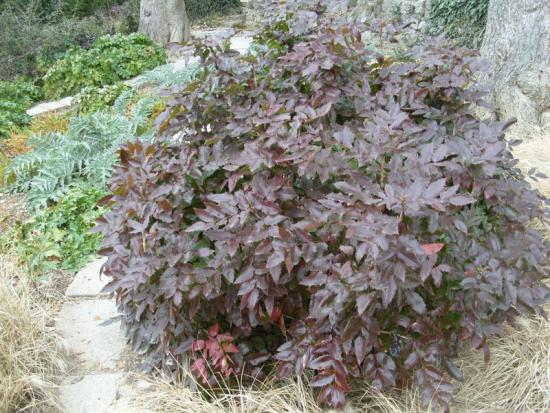
As for sanitary pruning, it is done before the bush blooms. At the same time, gardeners remove all weak, drying and diseased shoots.
Organization of wintering
Adult mahonia does not need shelter. For the winter, you can simply mulch it with dry straw or peat. As for young animals, they must be covered with spruce branches.
You can also, for greater protection from frost, hill up the root system, at the same time covering it with a large mound of earth. The branches of the plant should be covered only if the onset of severe cold is inevitable.
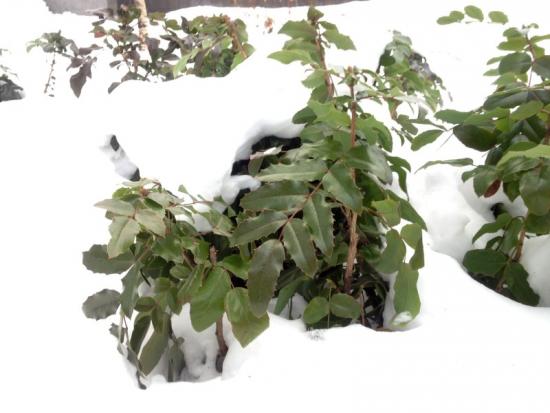
This can be done using hay, pine needles, last year's leaves, various rags or felting felt. It is recommended to remove shelters as soon as a thaw sets in. This is necessary so that the earth and bushes can warm up.
Using mahonia for domestic purposes
It has already been mentioned above about the use of the plant for medicinal purposes.
However, it can also be used to create winter bouquets, fill space under taller bushes and trees, make delicious wines, and create all kinds of desserts and toppings.
In addition, it makes an excellent food coloring for compotes and Easter eggs.
And also paint for the fabric from which designers sew clothes for allergy sufferers and small children.
How is Mahonia holly used in landscape design?
This plant is widely used in landscape design. It is used to protect berry and fruit trees from diseases and pests, attract beneficial pollinating insects to the garden, and create a background for microborders.
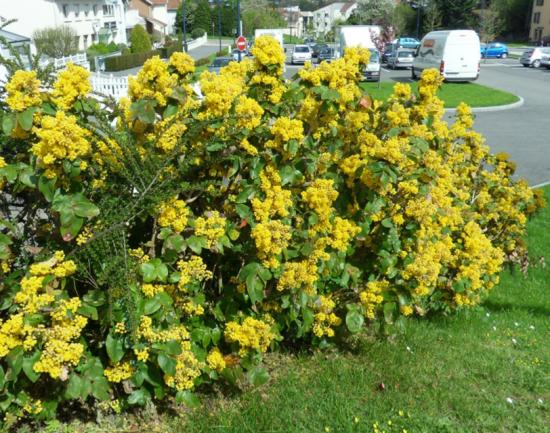
Since mahonia forms thickets as it grows, it is also often used to “knock out” those trees and shrubs whose bottoms do not look very attractive.It is also good in group plantings and rockeries, original bouquets and wreaths.
Some gardeners plant it on hillsides and near stone sculptures for the same purpose, to make the compositions more decorative.
Combination with other plants
Mahonia holly is excellent for creating alpine slides. It perfectly sets off the beauty of other plants: magnolia, azalea, camellia, Japanese quince and so on. It looks special next to coniferous shrubs and trees, as well as roses.
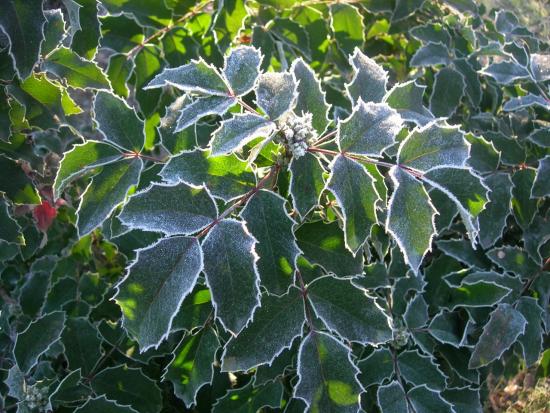
At the same time, mahonia is capable of creating a truly fabulous spectacle. Experienced gardeners also recommend planting it if you don’t want your garden to look dull and abandoned in winter.
Since the plant never fades, it perfectly “revitals” the overall landscape, making it more refined and harmonious.
Conclusion
In conclusion, we can say that holly mahonia has every chance of becoming popular among domestic gardeners.
The plant is beautiful, bears edible and healthy fruits, looks great in a duet with other plants, stone compositions and other decorative elements.
And in itself it is luxurious. It can also withstand frost and does not require special care!
Let's watch another interesting video on the topic:
So, it is not clear why it is still not so widespread in Russia. It's time to change the situation! Take it and plant a few mahonia bushes on your site.
And in gratitude she will give you delicious berries that taste no worse than barberry or the same grapes.



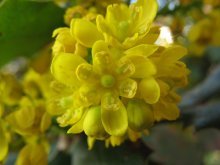
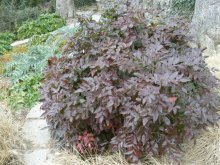
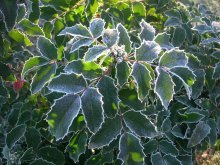


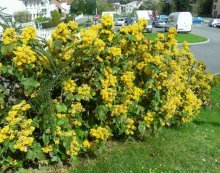
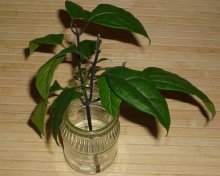

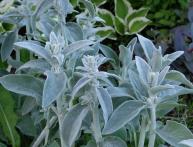
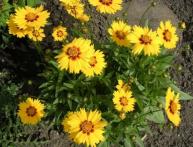
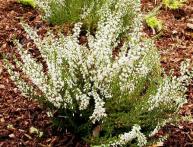
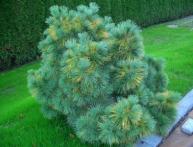

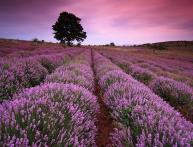

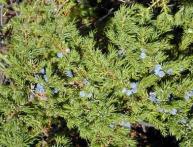
Comments
In your photos, it certainly looks gorgeous and will fit perfectly into any design project.The presence of medicinal properties and qualities makes me think about planting this plant in my yard at home.
Last fall I noticed this plant in the south; it grew wild on the avenue, and it had these berries that looked like grapes. I photographed them, but didn’t know their names. I wanted to try it, but I thought: what if they are poisonous? Can they be eaten? Otherwise I'll go there again in the fall.